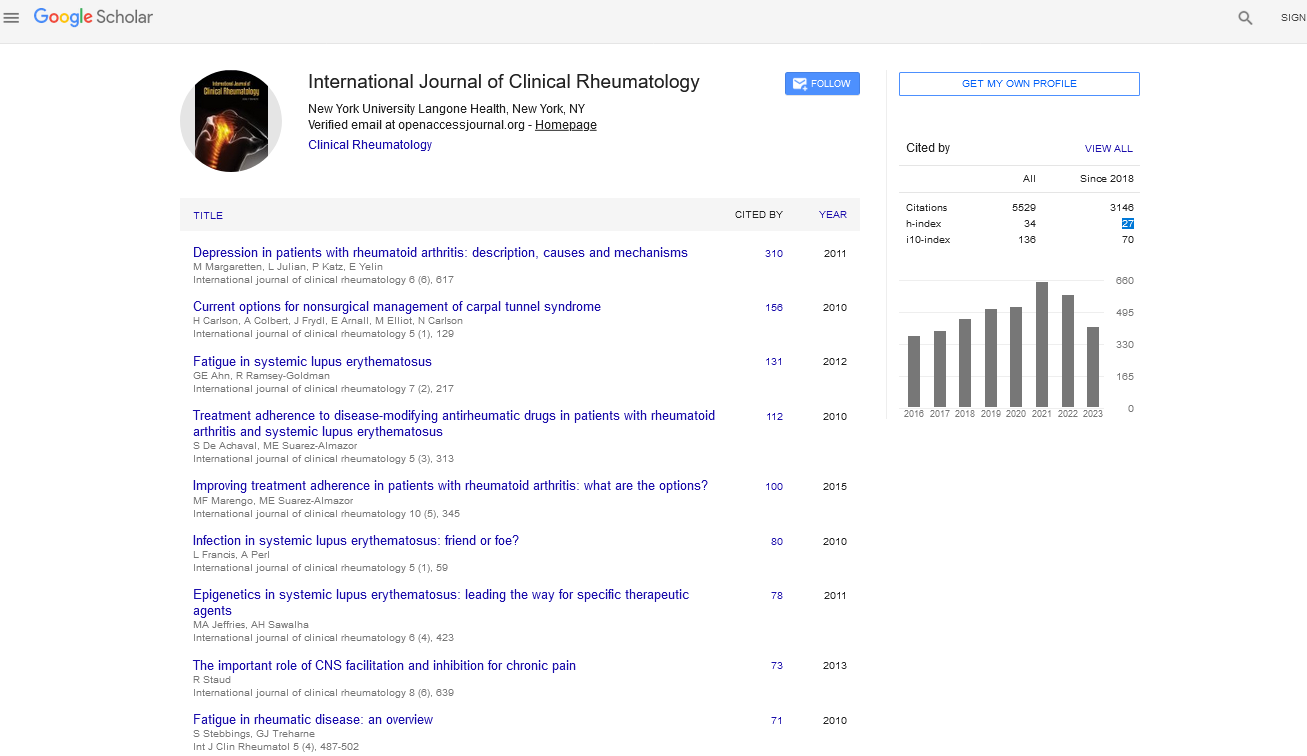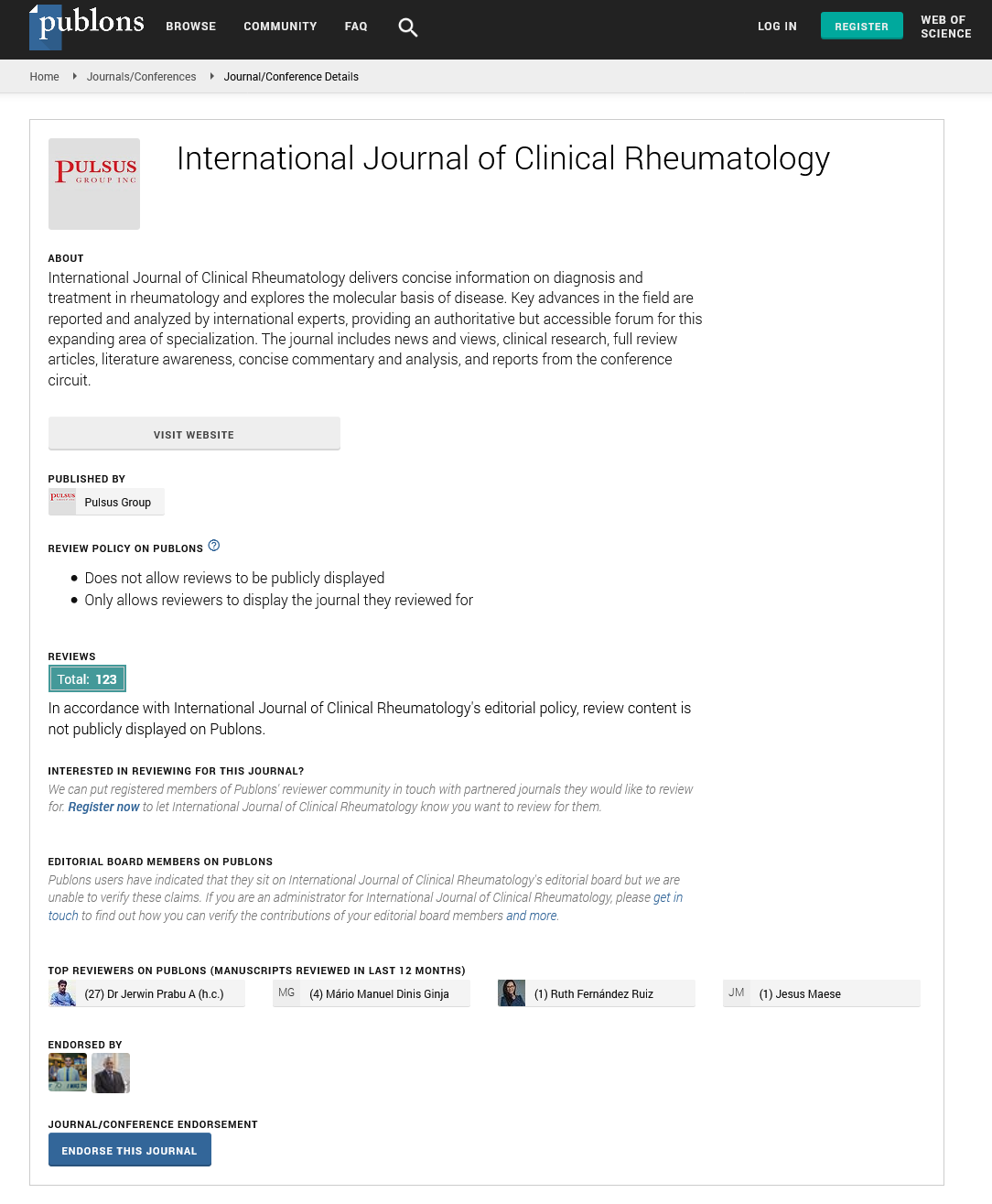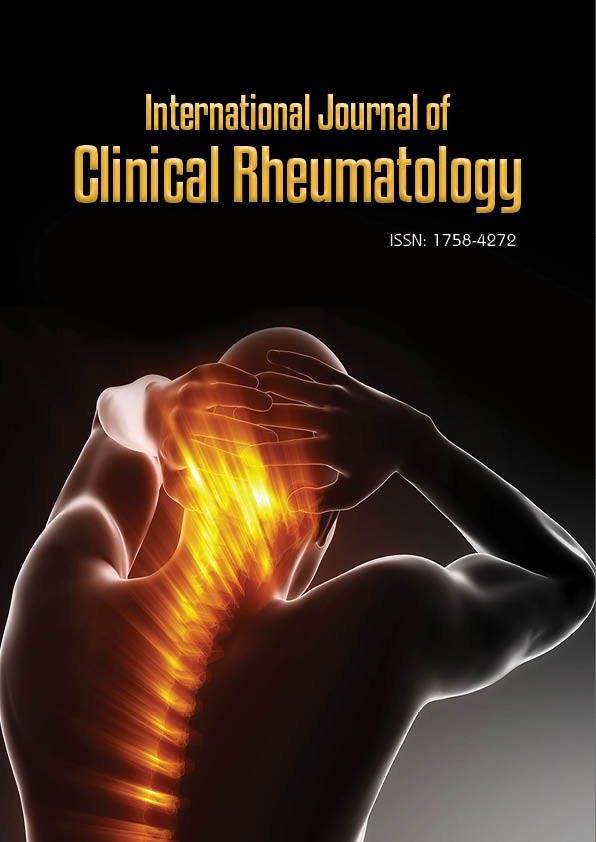Perspective - International Journal of Clinical Rheumatology (2025) Volume 20, Issue 1
The Role of Immunotherapy in the Treatment of Rheumatoid Arthritis: Emerging Strategies and Future Directions
Emma Scott*
Department of Rheumatology, All India Institute of Medical Sciences (AIIMS), New Delhi, India
- *Corresponding Author:
- Emma Scott
Department of Rheumatology, All India Institute of Medical Sciences (AIIMS), New Delhi, India
E-mail: emma.scott54@live.com
Received: 02-Jan-2025, Manuscript No. fmijcr-25-162981; Editor assigned: 04- Jan-2025, Pre-QC No. fmijcr-25-162981 (PQ); Reviewed: 18-Jan-2025, QC No. fmijcr-25-162981; Revised: 23-Jan-2025, Manuscript No. fmijcr-25-162981 (R); Published: 30-Jan-2025, DOI: 10.37532/1758- 4272.2025.20(1).410-413
Abstract
Rheumatoid arthritis (RA) is a chronic autoimmune disease characterized by systemic inflammation and progressive joint destruction. The treatment landscape of RA has evolved considerably over the past few decades, shifting from traditional disease-modifying antirheumatic drugs (DMARDs) to the advent of biologic agents and more recently, targeted immunotherapies. Immunotherapy in RA aims to modulate the immune response and prevent tissue damage by targeting specific components of the immune system, such as pro-inflammatory cytokines, B cells, and T cells. This article reviews the current role of immunotherapy in RA management, focusing on the mechanisms, clinical efficacy, and safety profiles of biologic therapies, Janus kinase (JAK) inhibitors, and emerging strategies. Additionally, the article discusses the challenges and future directions of immunotherapy in RA, including personalized medicine approaches and the optimization of long-term therapy.
Keywords
Rheumatoid arthritis● Immunotherapy● Biologic agents● Cytokine inhibition● JAK inhibitors● B cell depletion● Immune modulation● Personalized medicine
Introduction
Rheumatoid arthritis (RA) is a chronic, systemic autoimmune disorder that primarily affects the synovial joints, leading to inflammation, pain, stiffness, and progressive joint destruction. It affects approximately 1% of the global population and is more common in women. The pathogenesis of RA involves a complex interplay between genetic, environmental, and immunologic factors, with the immune system mistakenly attacking the body's own tissues, particularly the joints. The introduction of biologic agents in the late 1990s marked a significant breakthrough in RA management. These agents, including tumor necrosis factor (TNF) inhibitors, interleukin-6 (IL-6) inhibitors, and B cell-depleting therapies, have drastically improved the management of RA, particularly in patients with moderate-to-severe disease. More recently, Janus kinase (JAK) inhibitors, a class of small molecule immunotherapies, have been introduced, offering another avenue for targeted therapy. Immunotherapy in RA focuses on modulating the immune response to prevent joint destruction and improve functional outcomes. By targeting key immune system components involved in the inflammatory cascade, immunotherapy aims to achieve sustained remission and improve quality of life for patients. This review examines the current landscape of immunotherapy in RA, highlighting the efficacy and safety profiles of existing treatments, emerging therapies, and the future of RA management.
Biologic therapies in rheumatoid arthritis
Biologic agents are designed to specifically target immune system components involved in the pathogenesis of RA. These therapies have transformed the management of RA, particularly for patients who have failed traditional DMARDs. TNF inhibitors were the first biologic agents approved for RA and remain the cornerstone of biologic therapy. These agents block TNF-α, a cytokine that plays a central role in the inflammatory process in RA. TNF inhibitors, including infliximab, etanercept, and adalimumab, have demonstrated robust efficacy in reducing disease activity, preventing joint damage, and improving physical function in patients with moderate-to-severe RA. Long-term studies have shown that TNF inhibitors can help achieve sustained remission, although they are associated with a risk of infections, malignancies, and injection site reactions.
Interleukin-6 (IL-6) Inhibitors: IL-6 is another pro-inflammatory cytokine involved in the pathogenesis of RA. IL-6 inhibitors, such as tocilizumab and sarilumab, work by blocking the IL-6 receptor, reducing inflammation and the production of acute-phase reactants like C-reactive protein (CRP). Clinical trials have demonstrated that IL-6 inhibitors are highly effective in reducing RA symptoms, improving quality of life, and slowing disease progression, particularly in patients with high levels of IL-6. However, these therapies are also associated with an increased risk of infections, gastrointestinal perforations, and liver enzyme abnormalities.
B cell depletion therapies: Rituximab, a monoclonal antibody that targets CD20 on B cells, is another biologic therapy used in RA. B cell depletion has been shown to reduce the production of autoantibodies and modulate the inflammatory response in RA patients. Rituximab is particularly effective in patients with RA who have failed TNF inhibitors. Although B cell depletion can lead to a significant reduction in disease activity, it is associated with an increased risk of infections, especially in patients with a history of hepatitis B virus (HBV) infection.
Costimulatory inhibitors: Abatacept, a selective costimulation modulator, works by inhibiting T cell activation through the CD28-CD80/CD86 pathway. It has been shown to reduce disease activity, improve function, and delay radiographic progression in RA patients. Abatacept is particularly effective in patients with inadequate responses to TNF inhibitors. It is generally well tolerated, although it may increase the risk of respiratory infections and certain malignancies.
Janus Kinase (JAK) inhibitors in rheumatoid arthritis
JAK inhibitors represent a newer class of small molecule immunotherapies that target intracellular signaling pathways involved in immune cell activation. These inhibitors are particularly attractive for patients with RA who cannot tolerate biologic therapies or prefer an oral treatment option.
Tofacitinib (Xeljanz): Tofacitinib, the first JAK inhibitor approved for RA, inhibits JAK1 and JAK3, which are involved in the signaling pathways of several pro-inflammatory cytokines, including IL-6, IL-17, and TNF. Clinical trials have shown that tofacitinib is effective in reducing disease activity and improving physical function in RA patients, particularly those who have not responded to traditional DMARDs. However, tofacitinib is associated with an increased risk of infections, cardiovascular events, and malignancies, particularly in patients with a history of cancer or serious infections.
Baricitinib (Olumiant): Baricitinib is another JAK inhibitor approved for RA. It selectively inhibits JAK1 and JAK2, affecting the signaling of several cytokines involved in RA. Studies have demonstrated that baricitinib significantly reduces RA symptoms, improves physical function, and prevents joint damage. Similar to tofacitinib, baricitinib carries risks of infections, thrombosis, and malignancies, and it should be used with caution in patients with a history of these conditions.
Upadacitinib (Rinvoq): Upadacitinib is a selective JAK1 inhibitor that has shown efficacy in patients with moderate-to-severe RA who have failed conventional therapies. Upadacitinib has demonstrated similar benefits to tofacitinib and baricitinib, with a favorable safety profile. The main concerns associated with upadacitinib use are the risks of infections, thrombosis, and liver enzyme abnormalities.
Emerging therapies
Several new immunotherapeutic approaches are being explored for RA, including inhibitors targeting other pro-inflammatory cytokines, immune checkpoints, and novel small molecules. Research into the role of interleukin-17 (IL-17), interleukin-12/23 (IL-12/23) inhibition, and Janus kinase 3 (JAK3) inhibition shows promise in the future treatment of RA, particularly in patients who do not respond adequately to existing therapies.
Discussion
Immunotherapy has revolutionized the treatment of rheumatoid arthritis, offering more effective and targeted therapies that can significantly improve disease outcomes. Biologic therapies, such as TNF inhibitors, IL-6 inhibitors, and B cell-depleting agents, have dramatically improved the ability to control RA symptoms and prevent joint destruction. JAK inhibitors, with their oral administration and broad immune modulation, have become a valuable addition to the RA treatment armamentarium. However, challenges remain, including the cost and accessibility of biologic therapies, long-term safety concerns, and the development of resistance to treatment. As RA is a heterogeneous disease with varying levels of severity and progression, personalized medicine approaches that tailor treatment based on individual patient characteristics, including genetic profiles, are becoming increasingly important. Ongoing research into novel immunotherapies and combination therapies may further improve the therapeutic landscape for RA, offering even more tailored and effective treatments.
Conclusion
Immunotherapy plays a central role in the modern management of rheumatoid arthritis, offering targeted treatments that can significantly reduce disease activity, prevent joint damage, and improve the quality of life for patients. Biologic agents, such as TNF inhibitors, IL-6 inhibitors, and B cell-depleting therapies, have transformed RA care, while JAK inhibitors provide an important alternative for patients who require oral therapies. As research continues, new immunotherapies and personalized treatment approaches are expected to further improve outcomes and provide more options for patients with RA.
References
- Ndrepepa G, Kastrati A. Gamma-glutamyl transferase and cardiovascular disease. Ann Transl Med. 4-481 (2016).
- Emdin M, Pompella A, Paolicchi A. Gamma-glutamyltransferase, atherosclerosis, and cardiovascular disease: triggering oxidative stress within the plaque. Circulation. 112,2078-80 (2005).
- Grundy S. Gamma-glutamyl transferase another biomarker for metabolic syndrome and cardiovascular risk. Arterioscler Thromb Vasc Biol .27,4-7(2007).
- Dupont A, Constantin A, Soubrier M et al. DAS28-gamma GT pour la prédiction du risque d’événement cardiovasculaire majeur dans la polyarthrite rhumatoïde : résultats issus de la cohorte ESPOIR. Revue du Rhumatisme. 89,A35-6 (2022).
- Dessein PH, Stanwix AE, Solomon A. Could Disease Activity Score in 28 Joints–Gamma-glutamyl Transferase Use Improve Cardiovascular Disease Risk Management in Rheumatoid Arthritis? The Journal of Rheumatology.4, 1729‑31(2020).
- Vergneault H, Vandebeuque E, Codullo V et al. Disease Activity Score in 28 Joints Using GGT Permits a Dual Evaluation of Joint Activity and Cardiovascular Risk. J Rheumatol. 47, 1738-1745 (2020).
- Aletaha D, Neogi T, Silman AJ et al. 2010 Rheumatoid arthritis classification criteria: an American College of Rheumatology/European League Against Rheumatism collaborative initiative. Arthritis Rheum.62,2569-81.
- Framingham risk score. (2023).
- Touboul PJ, Hennerici MG, Meairs S et al. Mannheim intima-media thickness consensus. Cerebrovasc Dis. 18,346-9 (2004).
- Touboul PJ, Hennerici MG, Meairs S et al. Mannheim carotid intima-media thickness consensus (2004-2006): an update on behalf of the advisory board of the 3rd and 4th watching the risk symposium. Cerebrovasc Dis. 23, 75-80 (2007).
Indexed at, Google Scholar, Crossref
Indexed at, Google Scholar, Crossref
Indexed at, Google Scholar, Crossref
Indexed at, Google Scholar, Crossref
Indexed at, Google Scholar, Crossref
Indexed at, Google Scholar, Crossref
Indexed at, Google Scholar, Crossref
Indexed at, Google Scholar, Crossref


